Music is a universal language that often transcends words. It is not just a form of expression but also a powerful tool for learning. Utilizing music mind maps can help students better understand and remember complex music theories and concepts. This article presents 10 music mind map examples that are created specifically for students. These examples cover a wide range of music-related topics, providing a harmonious blend of learning and creativity. Whether you're a music student looking to enhance your studies, or a teacher seeking innovative teaching tools, these music mind map examples offer a rhythmical approach to learning.
What is a music mind map?
A music mind map is a visual tool that helps organize and explore the various elements and concepts related to music. It displays any knowledge regarding music involving different genres, various singers, songwriters, and the whole music industry. By the music mind map in Boardmix, you can get to know more about music, which assists you in brainstorming ideas, planning compositions, or simply exploring and expanding your knowledge.
10 Best Music Mind Map Examples:
Western Music History Mind Map
Welcome to the captivating world of Western music history! From ancient Greece to the modern era, this journey takes us through centuries of musical evolution. From the ethereal chants of the Middle Ages to the intricate counterpoint of the Baroque period, and the enchanting melodies of the Classical era to the expressive power of Romanticism, Western music has continuously evolved and influenced generations. As we explore the contributions of renowned composers and the emergence of various styles and genres, we will discover how Western music has shaped cultures worldwide and continues to thrive with innovation and creativity. Read the mind map below to learn more about Western music history.
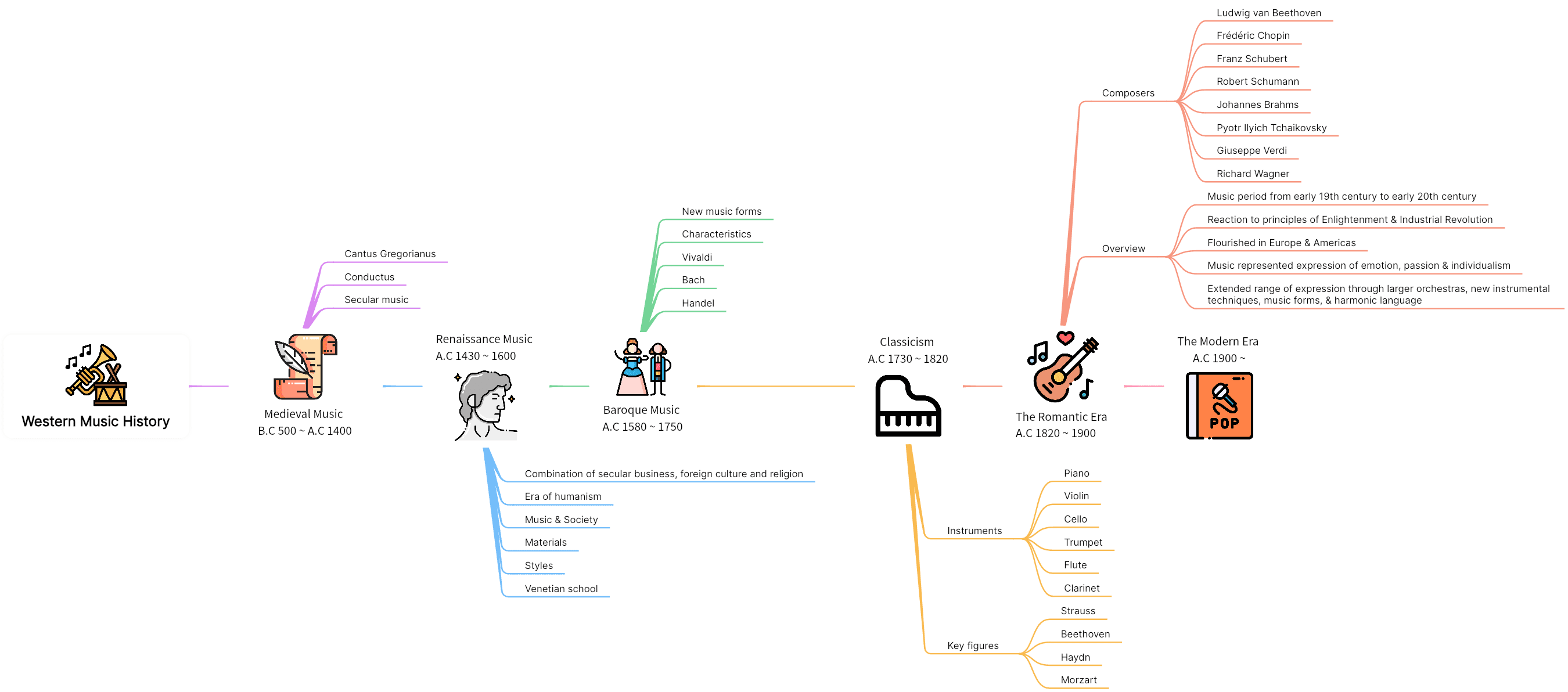
Rock n Roll Mind Map
This musical genre has revolutionized the music scene and captured the hearts of millions across the globe. Rooted in the combination of rhythm and blues, country, and gospel, Rock' n' Roll emerged as a powerful force of expression and liberation. With its energetic guitar riffs, catchy melodies, and dynamic rhythms, this genre became a symbol of youth culture, freedom, and rebellion. From iconic figures like Elvis Presley, Chuck Berry, and Little Richard, to bands like The Beatles, The Rolling Stones, and Led Zeppelin, Rock 'n' Roll has transcended boundaries, broken norms, and changed the face of popular music forever. Get ready to unleash your inner rock spirit as we delve into the electrifying and unforgettable world of Rock' n' Roll.
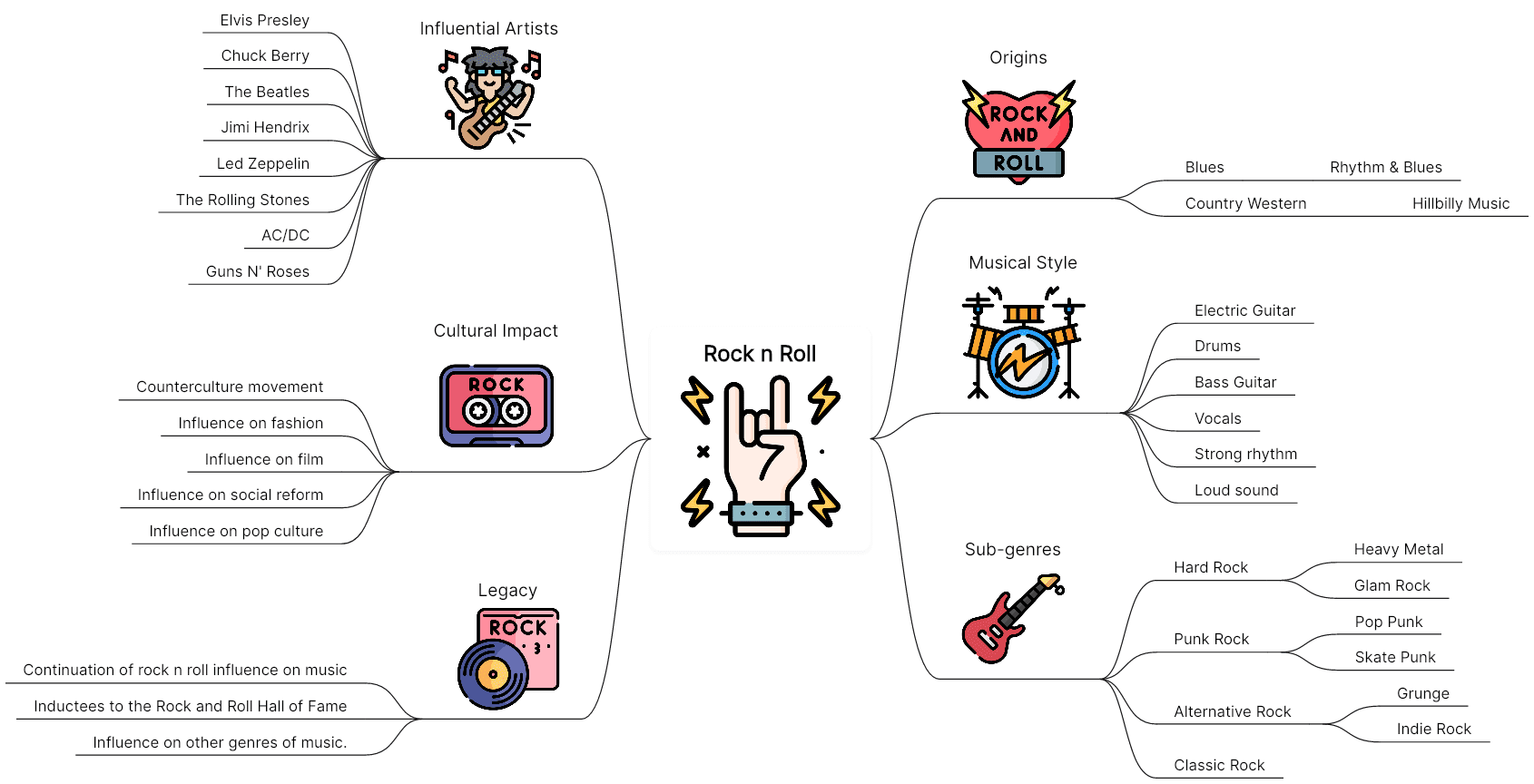
Taylor Swift's Songs Mind Map
Born in 1989, Taylor Swift is a prominent American singer and songwriter in the 21st century. From her early hits like "Love Story" and "You Belong with Me" to her evolution into more mature and introspective tracks such as "Blank Space" and "Lover," Taylor Swift has continually pushed artistic boundaries and reinvented herself as an artist. The following mind map displays her famous songs for you.
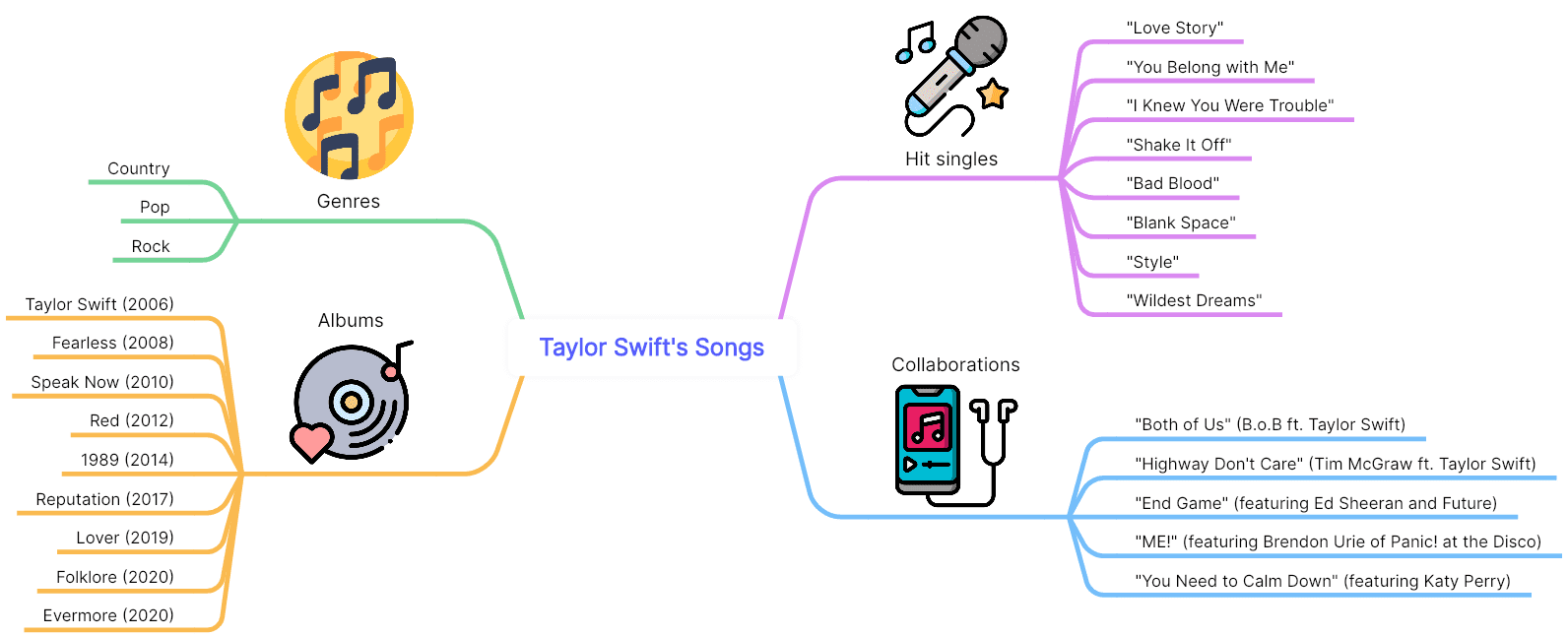
Pop Music Mind Map
Pop music, short for popular music, is a genre that encompasses a wide range of styles and influences, characterized by its mass appeal and commercial success. It emerged in the mid-20th century and has since become one of the most dominant and influential genres in the music industry. It incorporates elements from various genres such as R&B, rock, electronic, and hip-hop. The following mind map about pop music should give you a deeper understanding of it.
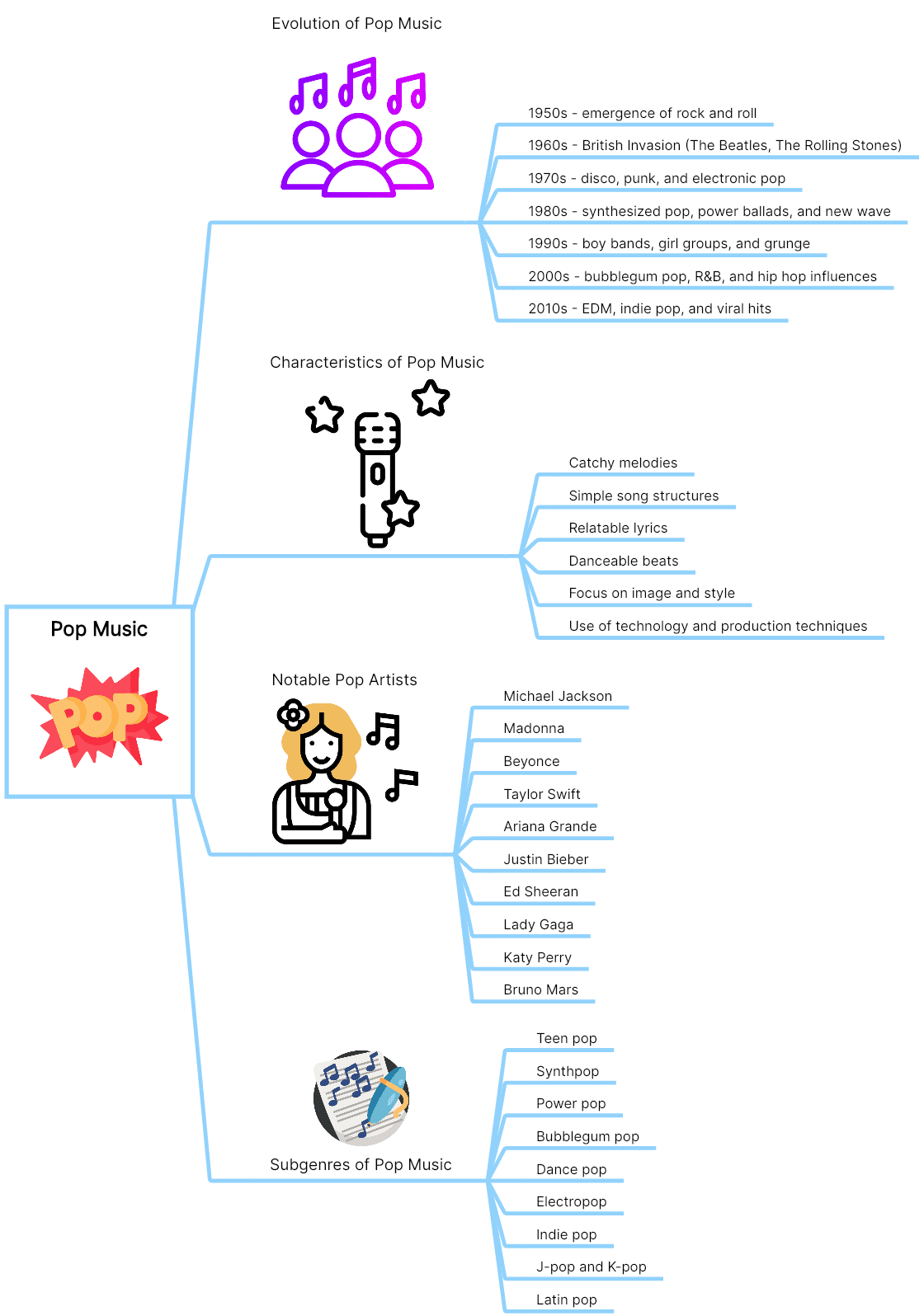
Jazz Mind Map
Jazz music, born in the late 19th century in the African-American communities of the United States, is a genre that embodies improvisation, swing rhythms, and a unique expressiveness. It arose as a fusion of African and European musical traditions, drawing from elements of blues, ragtime, and traditional African performances. The genre gained popularity in the early 20th century, becoming a significant force in American music and influencing musicians worldwide. Read the following mind map about Jazz music to learn more about it.
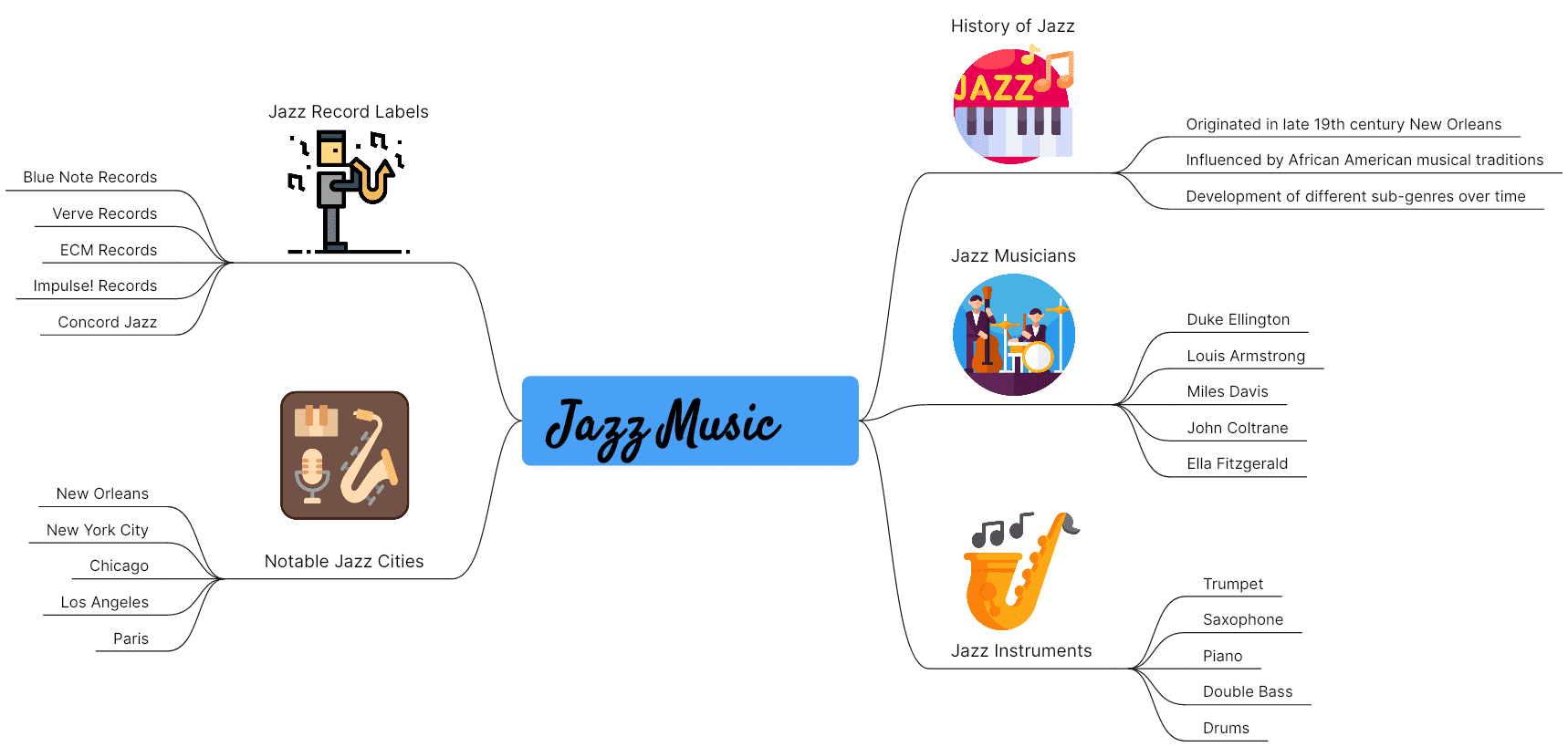
Blues Mind Map
Blues music originated in the 1860s in the Deep South of the United States. It incorporated many elements, including spirituals, work songs, field hollers, shouts, chants, and rhymed simple narrative ballads from the African-American culture. This is a mind map demonstrating a brief introduction to Blues music and should be a great example for students.

Latin Music Mind Map
Latin music is a vibrant and diverse genre that encompasses a wide range of styles and influences from the Latin American and Caribbean regions. It is known for its infectious beats, passionate lyrics, and energetic performances. Latin music has gained global popularity and features artists like Shakira, Enrique Iglesias, J Balvin, and Daddy Yankee. The mind map below should help you get to know more about Latin music.

African Music Mind Map
African music is a rich and diverse genre that reflects the vast cultures and traditions found across the African continent. With its deep roots and powerful rhythms, African music has had a significant influence on various genres worldwide. Traditional instruments such as djembe drums, kora, mbira, and balafon are commonly used, accompanied by vibrant vocals and dance. The following mind map should give you a brief introduction to African music. Read it and get to know more about African music!

Music Industry Mind Map
The music industry is a dynamic and ever-evolving field that encompasses various aspects related to the creation, production, distribution, and promotion of music. It involves a wide range of professionals, including musicians, songwriters, producers, managers, record labels, streaming platforms, concert promoters, and so on. The industry has undergone significant transformations over the years, largely influenced by advancements in technology. With the rise of digital platforms and streaming services, music has become more accessible to a global audience, allowing artists to reach fans worldwide with ease. Read the mind map below to learn more about the music industry.
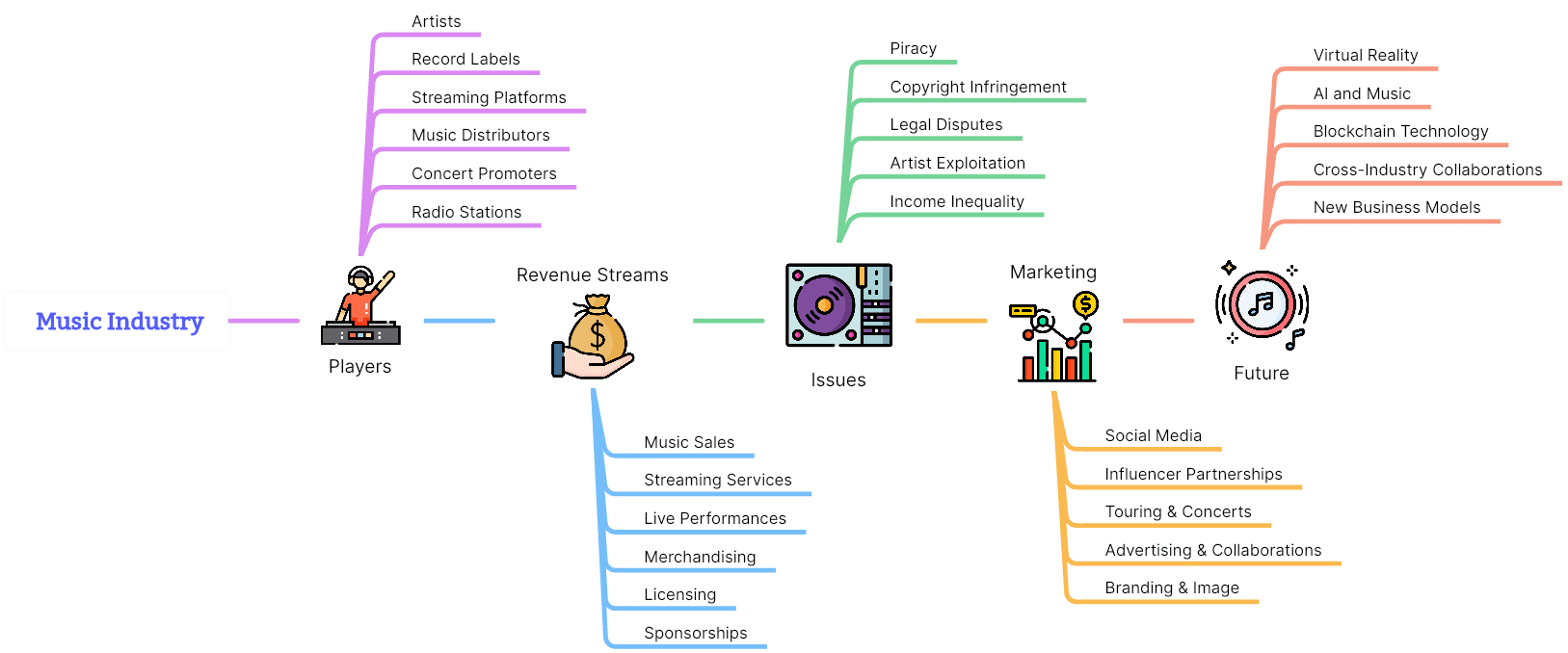
Ludwig van Beethoven's Mind Map
Born in 1770 in Germany, Ludwig van Beethoven was a renowned composer and pianist and is considered one of the most influential figures in Western classical music. Some of Beethoven's most famous works include his Symphony No. 9, featuring the iconic "Ode to Joy" melody, his Fifth Symphony with its distinctive four-note opening motif, and his Moonlight Sonata, a beloved piano composition. His compositions continue to be celebrated and performed worldwide, leaving a lasting impact on the music world.

FAQs about the Music Mind Maps:
What are music mind maps used for?
Music mind maps are versatile tools that can be used for various purposes within the realm of music. Here are a few common applications:
- Exploring music concepts: By music mind maps, you can delve into various music concepts and elements, such as music theory, harmony, rhythm, melody, and dynamics.
- Songwriting and composition: Songwriters and composers can use music mind maps to brainstorm ideas, map out song structures, and organize musical motifs. It serves as a creative tool to assist in the process of music production.
- Education and study: Using a music mind map, students and teachers can clarify knowledge regarding music and assist learning.
- Instrumentation and Orchestration: When orchestrating or arranging music, mind maps can be valuable in mapping out the instrumentation of a piece, indicating which instruments play which parts, and illustrating how they interact and create a cohesive musical arrangement.
Benefits of the music mind map
Music mind maps offer several benefits for musicians, educators, and music enthusiasts. Here are some of the advantages:
- Visual Organization: Mind maps provide a visual overview of music concepts, making it easier to understand complex relationships and connections. The visual structure helps to organize information clearly and intuitively, enhancing comprehension and memory retention.
- Creativity and Inspiration: Mind maps encourage creativity by allowing for non-linear thinking and generating new ideas. They provide a platform for brainstorming, exploring different musical possibilities, and sparking inspiration for composition, improvisation, or songwriting.
- Comprehensive Understanding: Music mind maps help in grasping the broader context of music. By mapping out different elements, such as genres, instruments, techniques, and theory, individuals can gain a more comprehensive understanding of music as a whole.
- Efficient Learning: Mind maps facilitate efficient learning by breaking down complex topics into smaller, interconnected components. This visual approach helps learners absorb information more effectively, as it appeals to different learning styles and makes studying more engaging.
- Organization and Planning: Mind maps serve as effective organizational tools for musicians and educators. They can be used to structure practice routines, plan lessons, map out musical projects, or outline the development of compositions. This helps with time management and staying on Track: Mind maps can act as a visual timeline or roadmap, keeping musicians on track with their goals and projects. By visually laying out the steps needed to achieve a goal, individuals can stay focused and motivated throughout the process. It also allows for easier tracking of progress, helping identify areas of improvement or where more focus is needed.








